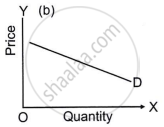Advertisements
Advertisements
Question
A perfectly elastic demand curve is parallel to the X-axis. Why or why not?
Solution
A perfectly elastic demand curve is parallel to the X-axis because the buyers are willing to buy any quantity at a given price.
APPEARS IN
RELATED QUESTIONS
Which is the implication of a horizontal demand curve?
The demand curve is horizontal
What will be the value of price elasticity in this case?
Match the following and select the correct option.
| Column I | Column II | ||
| (i) | Perfectly elastic demand | A. | Ed = 0 |
| (ii) | Perfectly inelastic demand | B. | Ed = ∞ |
| (iii) | Relatively elastic demand | C. | Ed < 1 |
| (iv) | Relatively inelastic demand | D. | Ed > 1 |
Match the following:
| Column I | Column II |
| A. Perfectly Elastic | (i) Ed = 0 |
| B. Perfectly Inelastic | (ii) Ed = infinity |
| C. Highly Elastic | (iii) Ed < I |
| D. Less Elastic | (iv) Ed > I |
When is the demand for a commodity said to be perfectly inelastic?
Would the elasticity of demand in the following case be unity, less than unity or greater than unity?
A rise in the price of a commodity increases total expenditure.
When is the demand of a commodity said to be inelastic?
Why is market demand curve more elastic than an individual demand curve?
Indicate the degree of elasticity of demand of the following demand curve.

What is the price elasticity of demand for the following demand curve:
Straight line demand curve parallel to Y-axis.
